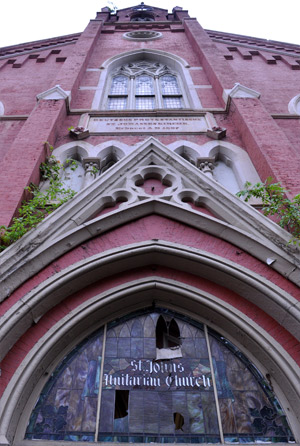Following a series of forums and community meetings, members of the Knox Hill Neighborhood Association located in North Fairmount have said that the city's
Vacant Building Maintenance License (VBML) hurts neighborhood development. Following increased fees passed in 2006, the VBML program has come under scrutiny from the very community in which it was meant to assist.

The VBML program was originally created to deal with troublesome vacant buildings that pose public health and safety concerns. According to city officials, the program requires building owners to bring properties into a general state of upkeep that preserves the integrity of the building, keeps it structurally sound for police and fire officials, and keep properties from sliding into serious states of blight. However, some neighbors believe that the program needs to be reexamined.
"Essentially the VBML is no longer an effective tool. Given the foreclosure crisis and difficult economy, the market has changed," said Paul Wilham, President,
Knox Hill Neighborhood Association. "Obviously the City Vacant Building Task Force wants to keep the VBML as it generates limited revenue and they are reluctant to do the hard work of actual enforcement of our building codes as other cities do."
Wilham, and the Knox Hill Neighborhood Association, believe that the VBML should be eliminated entirely and replaced by specific repair orders made by city inspectors.
Edward Cunningham, Division Manager of Property Maintenance Code Enforcement for the City's
Community Development Department, says that the license fees are used to offset the high costs of monitoring these at-risk properties, and that many of the fees can be refunded for those with rehabilitation plans in place.
"We try to inspect the properties every 30 days, and it costs a lot of money to deal with these structures," explained Cunningham. "This program is about preserving properties and getting them used once again. We're just trying to keep the buildings from deteriorating further."
Under the program, building owners are required to pay an annual VBML fee until the property is brought up to code. The fee starts at $900 for the first year, and doubles each following year with a maximum of $3,500 annually at year five. According to Cunningham, the property owner gets a full refund for the current year in which the property is finally brought into code, and since 2008, owners are able to have fees suspended for the first two years with an appropriate rehabilitation plan in place.
"The program is not a silver bullet, but we've got to have a balance," Cunningham said. "Vice Mayor Qualls is working with a task force that is looking at this program, and others, to determine how we can best preserve our historic building stock."
In the mean time, Wilham is leading a petition drive, calling for the abolition of the VBML program, that will eventually be submitted to Cincinnati City Council.
Writer:
Randy A. SimesPhotography by Scott BeselerStay connected by following Randy on Twitter
@UrbanCincy
Enjoy this story?
Sign up for free solutions-based reporting in your inbox each week.